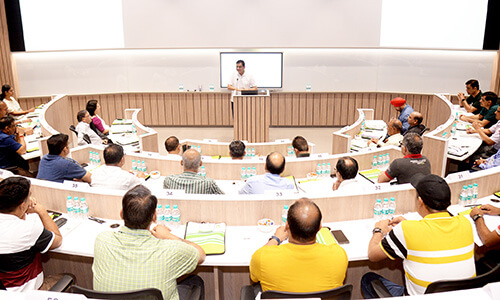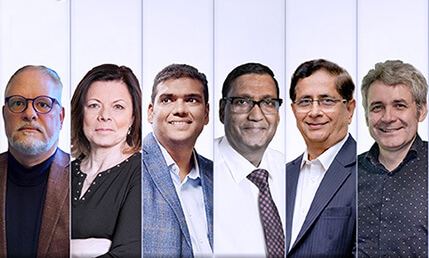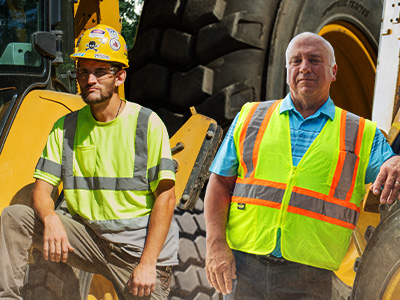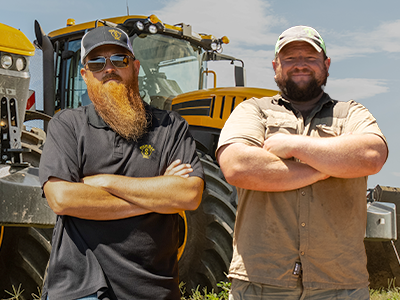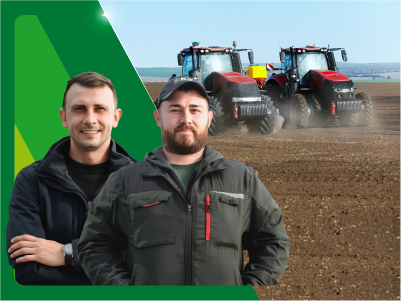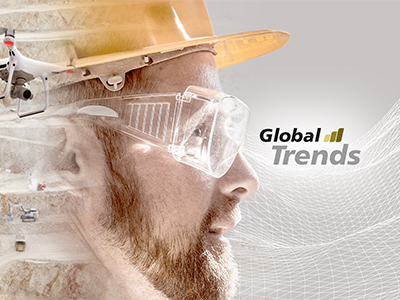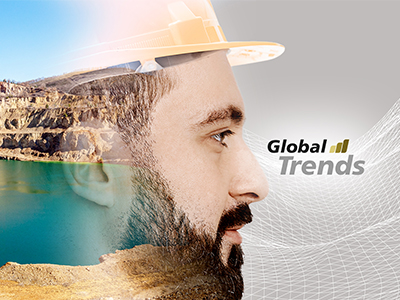welcome the first of our guests to the studio today.
Mining Magazine since 1909 has provided those in the industry with in-depth technical insight into all the operational aspects of mining. It was founded by none other than Herbert Hoover, who would later become the 31st US President. Today, its editor in chief is Craig Guthrie. He leads an editorial team to provide industry coverage on critical midstream operations, technology, computing and more in the mining industry. Expert in journalism, social media, digital media and news writing, he is a communications professional with a specialised focus on digital channels.
Let's have him on stage. Craig, why don't you join me?
Craig, a very warm welcome to Global Trends.
I'm delighted to be here. Thanks for having me.
Wonderful, now it's a pleasure to have you, and as usual, though, before we get started with our guests, don't miss the chance to follow us, watch the episodes on our social media channels and share your reactions and opinions.
So, Craig, let's start. How would you say the magazine's purpose has changed over the last 114 years?
Well, in some ways it hasn't actually changed, lots of threads from the past still continuing today. For example, it's still a forum to share methods to improve productivity and efficiency across the industry. So, the subjects may have changed, but the way we look at them hasn't.
And is ESG a subject that's coming up?
Yes, it's increasingly an area of our coverage alongside other modern developments such as artificial intelligence and battery electric vehicles. We have a broad remit from mine design all the way to processing. It's a huge value change, a huge variety of disciplines and a really broad geographic area.
So with that in mind, I guess there's no typical reader for the magazine.
If I was to define an indicative group, it would be the C-suite. But the C-suite focused on the technology and operations side of things. which brings us neatly into ESG.
In many companies, the ESG officer is in that C-suite position. So, what's driven that?
So, what we've seen at a corporate level is that net zero goals have been set into the future, 2030, 2040 even 2050. So, our leadership is focused on actually operationalising those goals, achieving them on the ground. And that involves technology around that, it involves mine design, plant design, swapping out the fleet for electric fleets. The conversation is how to do this at a practical level and it won't be something achievable overnight. It's going to take decades to achieve that. So our big challenge is this is all occurring at the time that demand is spiralling for transition metals, so it's a double-edged sword.
Excellent, so, for all this talk of ESG, mining can be accused of greenwashing. So, can mining ever be described as sustainable, especially when we're using a finite resource?
Yes, that's the charge. For all the moves to renewable energies, wind, solar for example, we will need minerals. Recycling batteries will meet only a tiny percentage of the demand needed for that. We need to help the world move away from fossil fuels and towards minerals.
Those minerals, those transition metals, they're going to become the new oil and gas, I suppose.
Effectively, yes, but they'll be consumed in a very different way. They will be used and then recovered. They're not completely consumed like fossil fuels.
But will we reach a point where extraction decreases, all our existing metals will be infinitely recyclable?
Potentially, but only very far into the future. Most models expect global population to keep growing into 2080, 2090, and they will all need electricity and development to emerging populations. So, they'll need new materials.
Now let's give viewers an idea of how these policies are working out. What are some ESG examples you've seen?
Well, we're seeing a large process of digitalisation and automation taking across the industry. For example, big players are swapping out diesel trucks for battery electric trucks. We're also seeing the same process with automation of drilling rigs. For example, a controller in Finland could operate a drilling rig in Latin America for example, what we're aiming for is a fully autonomised, fully digitalised mine that's low footprint. For example, an underground mine where all the operations are under the surface and only a very small footprint above the surface.
And then in ESG, we have the letter S for social. So, can you talk to me more about that?
True, in certain jurisdictions, mining is an important employer. And if all the workforce was to be replaced with robots, that would have a major impact on that country's economy. So, there are also new standards coming into place playing an important role in societal impacts. And they are impacting on tailings, waste and end of life. But there are some good things around about how we can convert the waste into positives for the society.
So, can we?
Yes, for example, we've been working with a miner in Kazakhstan who's used the tailings from their mine and converted it into an aggregate that can be monetised for their local community. Another example is Vale, the Brazilian iron ore miner, is using sand from its operations in construction materials fulfilling an important need. So there are some important developments there, particularly around traceability.
Yes, so, let's talk about traceability. You mentioned standard bodies. They've put pressure, or they're a source of pressure on companies to comply with ESG obligations. Shareholders are another. Are we seeing any pressure from consumers yet?
I don't think that we have the same level of scrutiny yet, but some majors are preparing for it, and the EU is preparing legislation that will have more demand, more traceability in the supply chain. And for example, Rio Tinto has already introduced formative ideas, such as partnering with a blockchain company to trace the metals in an aluminium can from the mine all the way to the market. And it's not too long before consumers will get this and they'll demand more transparency.
Well, I believe that's a perfect segue for my next question. And what is the trend in consumer and corporate circles?
Well, like I alluded to at the start, it starts at that high level in pressure from investors. But it will still filter down to the public level. You don't see protests around mining to the same degree you see around oil and gas. If groups took a closer look at the industry, it could become a reality. There was an interesting example earlier this year where a London university barred its graduates from even talking to mining companies as a potential career. And that was a real shock to the mining community because we see ourselves as the solution, not the problem.
That is indeed an eye-opening anecdote that you shared with us. Now, you've drawn a distinction between oil and gas companies and mining. Why is that?
Well, we face the same issues in many ways. No matter how many resources the majors have available to them, they can't find quite the right message to get that across to the public. So if you go to an oil and gas or a mining conference, there's the same message going around. How can we alert or inform the public and particularly the younger generation about the importance of this industry in your daily lives? The difference is that we're here to stay for longer than oil and gas industry because we are needed for the transition.
Excellent, and, well, Craig, you're well placed to be able to help the industry deliver that. And I want to thank you for sharing your thoughts with me today, but don't leave quite yet because it's time for me to put you in the hot seat. We've asked our social media followers to submit questions to our guests, and I've picked this one for our Ask Away! segment. And the question is: if the industry wants to adopt and present a more sustainable face, what are three things it could do?
Well, it's a very big question, but I'll try my best. I think the first area I would look at is responsibility, the mining industry needs to see itself as a responsible stakeholder and that involves a new level of transparency into areas such as water use, land use that they're not really comfortable with at the moment. Another area I would identify is digitalisation and automation, really maximising the impact of and fully committing to it. Finally, there is a focus on people and communities that needs to be upped. They need to genuinely see what they're doing as important for the people in these communities and design that from the concept stage of mines all the way through to the end processing stage and another important area is brownfield sites need to have the same care and attention because most of the world's mines are existing and they need to be transformed.
Well, we ended on a good note, transformation. And I'd love to pick that up in more detail, Craig. But we should move on to our next guest, Craig Guthrie, editor in Chief of Mining Magazine. Thank you and join us again for our discussion in just a moment.
Well, Craig gave us a journalist's point of view in understanding the bigger picture.
Now, we're going to hear from someone who's on the sharp end of helping companies deliver those sustainability plans that Craig just described.
